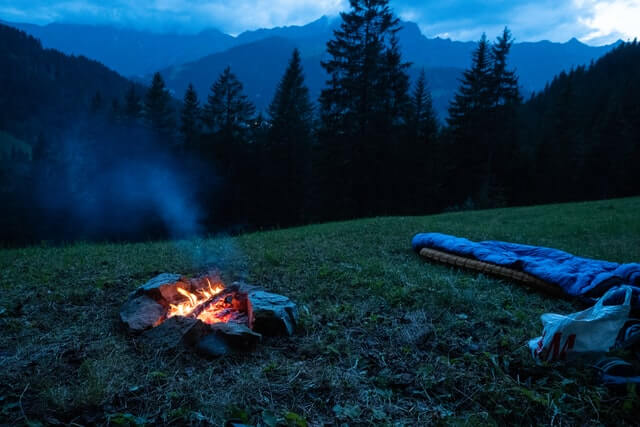Camping trips usually hit nights. So, besides a comfy tent and a comfy sleeping bag, good liners are essential. And the truth is that a good liner is mostly underestimated. A good sleeping liner is not just about filling your sleeping bag. Instead, it’s more than that. The best thing about it is that it can extend your sleeping bag’s life. These sleeping liners give you a comfy sleep by adding warmth on chilly nights, softening the surface, protecting you from sharp stuff, and even protecting you when lying on used stuff.
Some liners are made of natural cotton, and some the synthetic fabric. Some bag liners possess abilities like water resistance and anti-stain qualities. Further, they are available in different sizes, temperature ratings, and prices. The best search is looking for a lightweight, compact, all-season sleeping bag liner. After our extraneous research, consulting industry, and market experts, we have pulled out the best top 7 sleeping bag liners for you.
Quick Recommendations
- Best overall fleece sleeping bag liner: Coleman 50°F Stratus Liner
- Insulated Liner: Sea to Summit Reactor Sleeping Bag Liner
- Best For all seasons: Litume All Season Sleeping Bag Liner
- Silk sleeping bag liner: Cocoon Silk Mummy Liner
- Best Of the Rest: Snugpak Fleece Liner, REDCAMP Fleece Liner, TETON Mammoth Liner
What is a sleeping bag liner?
A sleeping bag liner is a barrier sheet that is thin in width and portable. This barrier sheet can be used on camping nights or in hostel rooms. It is a handy protection gear against dirt, odor, and dust. It even enhances comfort and also fits according to your temperature needs.
Sleeping Bag Liners Benefits
- Protects your sleeping bag from getting dirty
- Extends the lifespan of sleeping bags
- It can be used in place of a sleeping bag
- It protects you from used stuff
- Protects you from the uneven surface
- Portable
- Highly efficient and handy for warmth and comfort
- Easily washed and dried
- Some are stain free
Top picks for the Best Sleeping Bag Liners
1. Coleman 50°F Stratus Liner
No wonder Coleman Stratus Liner is of prime quality. It is manufactured to suit your temperature needs on an icy cold night. It saves you well from trembling and uncomfortable sleeping experiences. The size is big, even suitable for taller campers. Being fair enough in size, it is remarkably ultralight-weight.
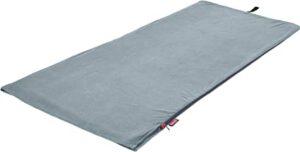
It also has an extra layer of fleece, making it independent of sleeping bags, making it suitable for winter and summer seasons. You can use it even as an alternative to the sleeping bag. This extra fleece and good quality material make it standalone, warm, and toasty. In our experience, it best fits those less than 6 feet tall. Moving towards cleaning, it is easily washable in the machine without distorting its quality and doesn’t even get stains.
Moreover, it comes with a stuff sack, sleek gliding zippers, and an elastic strap. This strap is of acceptable quality, hence, does not get loose. It clinches in your stuff tightly. One of the minor drawbacks of it is that it has a reasonably tight stuff sack. So, it may be a little tricky to stuff back your sleeping liner on the first use. Overall, it is a perfect one at an affordable price.
Pros
- Soft Fleece
- Easy to clean
- Stain free
- Affordable
- Zippers doesn’t get stuck
Cons
- Binding stitches are not that strong
- A tight stuff bag
2. Sea to Summit Reactor
Sea to Summit Reactor sleeping bag liner has a good range of temperature abilities. While lightweight and tidy, the original reactor initiates 14F of warmth. And with a heavy thermolite the temperature can extend to 25F. It even goes up to 32F. The best thing about it is that it is made up of thermolite with hollow core fibers, which are known to be the best insulators and even durable. They also dry quickly and are moisture-wicking.

Furthermore, the liner’s design is versatile as its hollow-core and firm knit construction makes it stretchy. This construction also contributes to its provision of an extra warm environment. Which ultimately increases comfort. Moreover, it has a mummy-shaped drawcord hood with a mini cord lock attached to it. This construction will be helpful when the temperature drops. You can lock yourself in. So, this style acts as an extra heat trapper. The last point in the good category is it’s easily washable.
However, the drawback is that it slides around in the sleeping bag. The material may initiate this scrunching up or sinking to the bottom. However, it is an effective equipment to provide a moderate boost on cold nights.
Pros
- Insulated
- A hood with an elastic strap
- Dries easily
- Soft and lightweight
- Maintain personal hygiene
Cons
- The body gets tangled in it
- It slides around in the bag
3. Litume All Seasons Liner
Litume All Seasons Liner is handy in cold weather, mainly because of its mummy style and no zipper. It has a locked foot style, which increases the temperature. Although it has a closed type, it is generously wide. Another good experience is that it’s breathable. So it doesn’t get damp and make you feel sick.
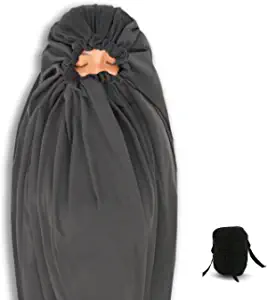
The construction material has fleece, which is soft like fluffy cotton and easy to clean and manage. In addition, it is fairly lightweight, weighing just 470g/16.6 ounces. And the temperature can build up to 27F. It is the best fit for a single person.
The downside is that it only has one strip at the hood, which requires you to put more stress on it to tighten it around your head. Also, it has no zipper, which does require you to get in yourself through the top hole. But this complaint somehow fades away because this design increases warmth and comfort.
Pros
- Box style contributing to extra warmth
- Thicker
- Easy to carry and lightweight
Cons
- Has only 1 hood cord
- Bit pricy
4. Snugpak Fleece Liner
Sungpak Fleece Liner is a decent and generous-sized one. It is made of thick polyester fleece, and its softness reflects when looking at its texture. Its brushed and sheared fabric brings this texture, which gives it a durable plush finish. This liner is breathable, so it a good moisture-wicking. It has a long zip that glides easily without snugging.
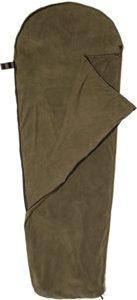
Furthermore, its cords and zippers are sturdy and firm. Adding more, the side zips make entering and getting out of it convenient. It even has loops at the feet which prevent it from swirling inside your bag. Stating its dimensions, it is 94 inches long by 30 inches wide. Hence, it has enough room. Besides, it has a good quality compression stuff sack that weighs 2 pounds. This compression bag fits into your backpack without filling in too much space.
Its downside experienced are that it may be tricky to get it back in the stuff sack. Also, it is a little bit heavier and bulkier. But, It does an excellent job.
Pros
- Side zippers
- Tying in loops
- Side zipper
- Moisture resistant
Cons
- A bit bulky
- May be tricky to pack it back in the stuff snack
5. Cocoon Silk Mummy Liner

This sleeping liner bag is super lightweight and compact because of its delicate silk material usage. It is made from 100% silk which is thin and highly portable. Although light, it is durable and firm because it is woven into a grid-like structure using high-quality and strong silk threads. As a result, this makes it more resistant to tears than regular silk. Cocoon Silk Mummy Liner is good insulating equipment.
Most importantly, it responds well to changing temperatures. It is warm enough in cold environments and cool enough in hot summers. Hence, an optimal heat regulator. Moreover, silk takes less time to wash and does not lose quality with the washes. It even has a hood. So, even if it slides down from the shoulders, the hood will secure the position.
However, it has a narrow bottom. It is a disadvantage in the way that you have limited foot space. In contrast, an advantage is how it contributes to the extra warmth. Plus, this design makes it less bulky and more compact.
Pros
- Good for backpacking
- Very soft material
- Compact and lightweight
- Easy to clean
- Comfortable
Cons
- Little tight for legs
6. REDCAMP Fleece Liner
This is another good sleeping bag liner on our list. It is distinct from the other liners in our list because it is convenient for couples. The REDCAMP Fleece Liner is made up of 100% polyester fleece.
In addition, it is breathable as well. Its weight is 1.9 lbs, which is a bit heavier, especially if you are an ultralight backpacker. Despite some extra weight, it’s compact so you can pack it easily. But we suggest car or RV camping due to its size and weight. This remains dry in light rain or dew without a stuff sack.
It comes with a carrying bag that looks durable and decent to carry. It has a plastic drawstring close carrying bag that can be strapped to your backpack or put in. The fleece liner is crafted with a hood. It also has a convenient addition: a side and a bottom zipper, a long-length zipper. The only drawback is that its zipper might make some fuss to open. However, this works brilliantly with double sleeping bags.
Pros
- Portable
- Comfortable and soft
- Adds good warmth
- Good design
- Easy to rollup
Cons
- Bit heavy for backpacking
- Zipper can be little tricky to close
7. TETON Mammoth Liner
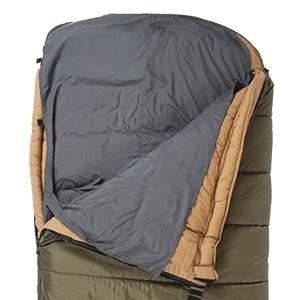
TETON Mammoth Liner is great to break the chill and give you time to cool off. It truly keeps the sleeping bag clean, and it is also easy to wash. Moreover, it dries super quickly. This sleeping liner has a 10-degree temperature rating, hence compatible with cold weather. It is made of durable, brushed poly fiber. It has a well-designed stuff sack with a barrel lock, drawstring, and handle. The liner also has a zipper at the top. Detailing it further, it has a round top.
Moreover, it is the best fit for mummy-style sleeping bags. The material used is adequate and of good quality. Also, it’s reasonably lightweight and fits small in the pack. It has a significant feature which is the Velcro strip which ensures its closure when not in use. Besides, it works proficiently with and without a sleeping bag.
However, it’s a bit tricky to adjust it inside the sleeping bag. The only solution is to position it accurately within the sleeping bag before zipping up the bag. Also, it does not feel much soft due to its fabric, but they should have added more thread for little extra softness. However, considering the prices, it’s a reasonable option out there.
Pros
- Comfortable and warm
- Machine washable
- Good quality material
- Keep bag clean
Cons
- Bit difficult to get in and out
- Small opening
How To Choose A Sleeping Bag Liner? Buyers Guide
Although a sleeping bag liner provides extra comfort and warmth, it sometimes gives you the comfort that your other equipment or sleeping bag can’t offer alone. So, when purchasing a liner, do consider the following five factors.
Shapes
There are various shapes and sizes of sleeping bag liners in the market. Each form has its specificity that is suitable to a particular environment and needs of camping or hiking. Here we have a brief list of commonly used shapes.
Rectangular: This is the most common shape of a sleeping bag liner. It’s spacious and allows for comfortable movement. Lastly, this versatile shape can fit in different sleeping bags.
Mummy: This shape is intended to fit closely all around the body. Further, it’s a good option for adventures in cold climates. It’s more form-fitting than a rectangular liner and can help trap heat more effectively.
Cocoon: This shape resembles the mummy but has a more spacious head area. It’s ideal for those who want the warmth of a mummy liner but prefer more room to move around in.
Envelope: This shape resembles a rectangular liner but has a hood and drawstring closure. It’s ideal for those who want the comfort and spaciousness of a rectangular liner but with added warmth and protection from the elements.
Double: This is ideal for two people or a couple. It has fair enough space to take two individuals in. But it also falls in the category of solo liners, who want extra space.
Material
Several materials are generally used for the crafting of liners. Each material has its specific properties.
Cotton: It has subsistent popularity due to its breathability, softness, and coziness.
Silk: Silk is a lightweight and luxurious material for warm climates. Additionally, it’s a super soft and moisture-wicking material that is efficient in keeping dry and cool.
Fleece: Fleece is a warm and cozy material for cold-weather camping. It’s soft and comfortable and traps heat to keep you warm and toasty.
Microfiber: This is a synthetic material that can quickly dry. Plus, it is breathable and lightweight.
Thermolite: This is another lightweight synthetic material that is a well-known heat trapper. It will dexterously keep you warm when the temperature falls. It is highly compact and convenient for backpackers.
Merino wool: This is a soft natural material. It has breathability and moisture-repelling properties. It’s also naturally odor-resistant, making it an excellent choice for longer camping trips.
Temperature Rating
Sleeping bag liners function as extra insulation and comfort layers that can be used within sleeping bags. Just as they are made with a variety of materials, the same way they come with various thickness and weight tags.
Regarding temperature rating, liners are not typically assigned a specific temperature rating like sleeping bags are. Instead, their temperature rating is generally described in terms of how many degrees of warmth they can add to a sleeping bag. For instance, a thin silk liner may increase the temperature from 5 to 10 degrees. On the other hand, a thicker fleece might fall in the range of 15 to 20 degrees.
There is one thing to bear in mind liners not made to be solely used in harsh and chilling weather. They are extra equipment for extra warming and comfort. They are best buddies in mild to moderate temperatures. Or to wisely keep your sleeping bags clean.
Size
Long: Long-sized liners are designed to fit individuals taller than 6 feet. They typically have a width and length similar to regular-sized liners but with added length to accommodate taller individuals.
Double: Double-sized liners are designed to fit two people inside a single big or double sleeping bag. Being wider than regular-sized liners, they come in with a width of around 56-60 inches and a length of about 72-75 inches or even longer.
Kids: Kid-sized liners are designed to fit children and smaller individuals. These kinds of liners are narrower in width and shorter to accommodate the kids. Their width ranges from 24 to 26 inches, and their length ranges from 60-66 inches.
Thus, consider the shape and size of your sleeping bag and your body when shopping for a liner. This will help ensure a comfortable and warm night’s sleep while camping.
Weight
Liners are available in different weights, which refers to the thickness and insulation properties of the fabric. The weight of a sleeping bag liner is typically measured in ounces per square yard or grams per square meter.
Here are some common weights of sleeping bag liners:
Lightweight (less than 3 oz/yd² or 100 g/m²): These liners are usually made of thin, breathable materials like silk or polyester. They add minimal warmth to a sleeping bag but can provide a comfortable barrier between your skin and the bag.
Mid-weight (3-6 oz/yd² or 100-200 g/m²): These liners are slightly thicker and warmer than lightweight liners. This weight is achieved by using either polyester or fleece. And can be significantly warm.
Heavyweight (more than 6 oz/yd² or 200 g/m²): These liners are the warmest and thickest of the three types. Denser insulating materials like fleece or wool put in the bulky weight. These are the leading choices for the icy season.
When choosing a sleeping bag liner, consider the climate you’ll be camping in and your personal comfort preferences. A lightweight liner may be sufficient for warm-weather camping, while a mid-weight or heavyweight liner may be more appropriate for colder temperatures.
Price
Prices vary with material, weight, size, brand, and additional features. Have a look at the general price ranges.
Budget: These usually cost around $10-$20. These are mainly nylon or polyester, made with less weight and softness. Therefore, these may not be sufficiently durable or warm.
Mid-Range: Sleeping bag liners in this price range usually cost around $20-$50. They are typically made of mid-weight synthetic materials like fleece or microfiber and may provide additional warmth and comfort.
High-End: Sleeping bag liners in this price range usually cost $50 or even up to $100. They are typically made of high-quality materials like silk, merino wool, or down and may provide significant warmth and comfort. They may also have additional features like antimicrobial coatings or unique shapes for specific sleeping bags.
It’s essential to consider your budget and camping needs when choosing a sleeping bag liner. While a budget liner may be sufficient for occasional use in warm weather, a mid-range or high-end liner may be more appropriate for colder temperatures or frequent camping trips. Lastly, a high-quality sleeping bag liner would be the best choice. This will save you from buying extra warmers, purchasing a new one, or repairing it.
FAQs
Are Sleeping Bag Liners Worth It?
Definitely yes! Even though they provide extra warmth, they still have several other benefits. Out them protecting you and your sleeping bag makes a liner stand out. You can use them alone if you are camping in summer. Further, reading about the temperature or season rating reviews regarding the sleeping bag liner would be better.
Are Cotton Sleeping Bag Liners Good?
The answer to this, too, is yes! The reason is that such sleeping bag liners are affordable and lightweight. They can easily fit into your backpack. Also, cotton sleeping bag liners are easy to clean and maintain. But, a drawback lies here. Cotton ones are not sufficiently durable and stain free.
Summary
Sleeping bag liners are remarkable camping gears to save the sleeping bag and you from dirt, odor, etc. As sleeping bags are tricky and time taking to wash and dry, sleeping bag liners are the opposite to it. These liners remove the sleeping bag washing problems and adjust with the temperature. We hope you will have a great deal of information plus what sleeping bag liner to choose with the help of our list of top 7.
Also Read:
